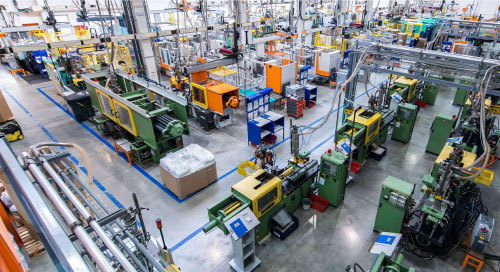Factory Digital Transformation Starts with Infrastructure

Smart Manufacturing. Industrial IoT. Industry 4.0. Whatever you choose to call it, manufacturers are racing headlong toward digital transformation.
But a number of manufacturing-specific challenges have slowed the pace of progress: the varied mix of machines on the factory floor, for example—which often come from different eras and vendors, and speak different languages.
Manufacturers typically have dealt with this situation by deploying point solutions for a single machine or use case. But even when this approach solves a particular problem very well, say predictive maintenance, its ROI is limited if the benefits don’t extend to the rest of the factory. And they can’t when the machines themselves—as well as their network standards, protocols, and infrastructure—are isolated from every other system in the factory.
Industry 4.0 demands the opposite: connected machines and integrated data, so manufacturers can expand an exciting use case, add new ones, and easily repeat them across machines and factories.
Such scalability is achievable, but it requires a new approach—one informed by perspectives from the IT and OT sides of the business. Transforming the whole factory at once isn’t possible (or desirable). But it is possible to approach smart manufacturing projects, however small, with a focus on how to scale their benefits. And it starts with simplifying the underlying infrastructure.
Industrial Infrastructure for Digital Transformation
Deploying smart factory applications as pilot projects makes good sense for manufacturers leery of jeopardizing production. But the complicated maze of infrastructure systems left behind—what Todd Edmunds, CTO of Smart Manufacturing and Industrial Edge Strategy, Dell Technologies, calls “accidental infrastructure”—needs tidying up before any major digital transformation can take place.
How? “By taking what IT knows about enterprise-grade infrastructure, and deploying a streamlined version of it at the factory edge,” says Edmunds.
Specifically, Edmunds points out the benefits of hyperconverged infrastructure, which combines storage, processing, networking, and security. By bringing all of these capabilities into a unified platform, hyperconverged infrastructure offers a highly scalable and repeatable foundation for digital transformation.
But, of course, infrastructure is useful only when it can connect to industrial computers. That’s why Dell Technologies partnered with PTC, whose ThingWorx software serves as a translation layer between the varied pieces of technology on the factory floor (and their different languages) and the enterprise-style infrastructure. “PTC knows OT very, very well—which is a big part of the reason we partnered with them for this solution,” explains Edmunds.
In short, the hyperconverged, software-defined nature of the Dell Technologies and PTC solution makes scaling easy. Because the platform is templatized, new applications can be added easily over time in a drag-and-drop way. And there’s no need to work with specialized teams and equipment to add infrastructure to support them. Instead, it’s just a matter of adding more servers, which can be bought as a small capital expense upfront or, soon, as infrastructure-as-a-service.
“When manufacturers have infinite compute capabilities, they can dream up an infinite number of new use cases—and new heights of efficiency.” @ToddEdmunds @DellTech @PTC
OT-IT Convergence and the Seeds of Innovation
With such an elastic compute pool, even advanced use cases that require huge amounts of memory and storage—augmented reality applications, for example—can be quickly dropped on top of the infrastructure as needed.
This kind of efficiency generates huge savings. “Now manufacturers and their systems integrator partners don’t have to engineer a separate infrastructure for each new use case and then try to get them to communicate,” notes Edmunds. The Dell Technologies and PTC solution automatically integrates different sources of data, which gives manufacturers the time and money to use that data in innovative ways.
But to reap the full value of this IT-style, repeatable infrastructure, Edmunds says IT and OT must work together. “It’s not enough to bring these enterprise technologies to the factory floor, where they haven’t existed before,” he adds.
While IT is responsible for managing the higher infrastructure layers, and brings their large data center expertise to the task, OT owns the edge compute layers. So both camps need to be involved in any smart manufacturing projects from the start.
After all, even if OT has traditionally been slower to embrace change, they know the machine data and how it should be used better than anyone. And ideally, they would also come to embrace new technologies for how they can improve, not derail, production.
Next-Gen Manufacturing
One customer, a manufacturer specializing in aerospace systems, needed to improve its product lifecycle management so it could provide crucial equipment like propellers at a moment’s notice. So it deployed the Dell Technologies and PTC infrastructure solution to get enterprise-level, real-time visibility into its fleet.
Now it’s building next-generation use cases like digital twins—projects that will be worth billions of dollars. And it’ll be able to quickly scale them across hundreds of thousands of assets and locations.
Simplified, IT-grade infrastructure at the factory edge helps manufacturers leave technology silos and the slow march toward digital transformation behind. “Because when manufacturers have infinite compute capabilities, they can dream up an infinite number of new use cases—and new heights of efficiency,” says Edmunds.